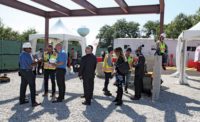Seeing drones and augmented-reality headsets up close isn’t the novelty it was for construction professionals just a few years ago. But attendees at the Oracle Industry Connect user conference in New York City on April 10-11 were still engaged, wanting hard answers on what this technology can do for their bottom lines.
“Construction is not exactly viewed as a leader when it comes to technology, but that is rapidly changing,” says Mike Sicilia, senior vice president and general manager for Oracle’s construction and engineering business unit. “There’s a lot of pressure on the labor supply chain right now, but there are trends that will help,” he says, citing augmented reality, robotics and other tools as force multipliers for industry workers.
The use of drones has expanded in construction, but some of the biggest hurdles remain in collating and applying the vast amount of data they can collect. And power users are starting to make more pointed demands of the manufacturers when it comes to deliverables. “Drones are still in the demonstration phase, and they have shown they have value, but it is critical to integrate this technology into our processes. The technology still needs to mature,” says Shay Bahramirad, director of distribution planning systems for smart grids and innovation at Illinois-based utility ComEd. In a panel discussion with drone makers and data-management experts, Bahramirad raised a point echoed by attendees at the Q&A afterwards—drones can fly a project, but what good is it to a workflow if timestamps and GPS data aren’t accurate enough to make critical decisions? “Collecting that information can be very hard, but that data can help us get our folks to the right place at the right time to prevent outages,” says Bahramirad.
Oracle has partnered with several drone data-collection companies, including an RFID-based system offered by Jovix. The firm has taken the sensors it used to log RFID tag locations from passing pickup trucks and moved them onto drones. “Now it flies around the laydown yard and sees what’s around,” explains Jon Chesser, senior vice president at Jovix. “It can get in the air and read all the RFID tags and calculate the GPS locations.”
Laydown yards for large power projects can have large amounts of materials coming in and out, and Jovix tracks these assets with active RFID tags. The GPS location is then compared with past data, tracking the materials as they move through the site. “Once we grid out the entire yard the information isn’t just geolocational, it’s geo-contextual, as we know where it is and has been,” says Chesser.
Even the promise of augmented-reality headsets has collided with the actual reality of construction. The makers of the DAQRI headset were turning heads a few years ago with their hardhat-ready display, but at the Oracle conference they were making more practical pitches to attendees from the engineering and construction sectors. “You could start in a green field and say this is what the building is going to look like, but that’s more just for clients,” says Paul Sells, director of technical sales for DAQRI. “Later on though, as I move through the working jobsite I can have the model in there as well. If I have a question about something I can drop an RFI and tie it back to that particular part of the model,” he says. With the DAQRI helmet on the market after a long development, Sells explains that customers are looking for real use cases rather than another neat toy. “If I make a note on the model, someone else can act on it—that’s the value,” he says.






Post a comment to this article
Report Abusive Comment